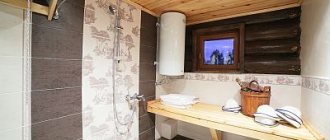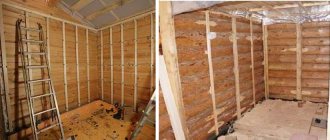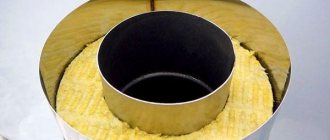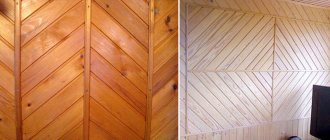The minimal open fires that every home has require careful attention. Non-combustible materials should be used to create comfortable and safe living conditions. Also, the use of fire-resistant boards, sheets or panels is also advisable in places where the presence of fire is not expected, for example in a roofing pie.
This review examines the concept of fire resistance (non-combustibility) in the context of building and finishing materials. Also presented are common non-combustible materials used at various stages of construction.
What is fire resistance of materials
Flammability should not be equated with fire resistance. Fire resistance means the ability of a building structure or material to resist the effects of fire and water in a fire.
The fire resistance limit is the time in minutes (in some cases, hours) from the start of a fire until the structure fails or warms up until the temperature on the surface opposite the fire rises to about 220°C, above which spontaneous ignition of organic materials is possible.
By structural failure we mean:
- Loss of bearing capacity.
- Collapse.
- Achieving irreversible deformations
- Formation of through cracks.
The fire resistance limit of wooden house elements is 15-20 minutes, steel frame ~ 30 minutes.
Combustible building materials are divided into:
| By flame spread over the surface | According to the toxicity of combustion products | ||
| G1 | Low flammable | T1 | Low risk. |
| G2 | Moderately flammable (organomineral materials) | T2 | Moderate danger. |
| G3 | Normally flammable | T3 | Highly dangerous. |
| G4 | Highly flammable (organic materials) | T4 | Extremely dangerous. |
Non-flammable materials include mineral materials: natural stones, concrete and mortars with mineral binders, ceramic and glass materials, metals.
Materials based on organic, plant components are normally and highly flammable . These include chipboard panels, fiberboard, and most synthetic plastic materials.
Low-flammable and moderately flammable are some organomineral materials that do not support combustion: fiberboard, wood concrete, wood impregnated with fire retardants. When exposed to open fire, they smolder, do not give open fire or become charred. Once the source of fire is eliminated, smoldering stops.
When exposed to fire, some organic materials do not produce an open flame, but sinter, melt and saturate the atmosphere with a number of gases harmful to human health. When burned, wood and polystyrene foam emit two types of gases (CO - carbon monoxide, CO2 - carbon dioxide), and plastics - phenol, aluminum oxide, sulfur and other harmful substances.
Types of heat-resistant wallpaper
For final finishing of the walls, you can use heat-resistant wallpaper. They are produced using several technologies. There are metallized roll materials that are made as follows.
The interlining, which is a product made from cellulose and synthetic fibers, is covered with thin aluminum foil. The top is coated with non-electrically conductive paint or embossed. Non-flammable wallpaper has interesting patterns and performs decorative functions. The material is durable.
Another type of non-flammable wallpaper is made from fiberglass. All components are of natural origin. The material washes well, has a beautiful appearance, and is suitable for premises of any purpose. The fire safety certificate confirms the high fire-retardant ability of non-combustible wallpaper.
Foam glass is a non-flammable thermal insulation material
Foam glass blocks are made from glass powder that has undergone a sintering process. The chemical composition of foam glass is identical to the composition of classic glass and includes oxides of silicon, calcium, sodium, magnesium, and aluminum.
Foam glass
Foam glass is a completely non-flammable material. It contains no oxidizing or organic components. When foam glass is heated to high temperatures, it only melts (like ordinary glass) without releasing gases or vapors.
The service life of foam glass blocks while maintaining their protective characteristics is more than 100 years.
Oriented Strand Board
Oriented strand boards (OSB) are produced by pressing chips with an adhesive resin under high pressure, which are manufactured in various thicknesses - from 6 to 30 mm. OSB boards are 3 times stronger than chipboard and MDF boards. Although the plates have such high strength, they are very flexible. Thanks to these properties, they are ideal for finishing and construction work, for example, for cladding ceilings, walls, attics and verandas, they are used in arranging the surface of subfloors, constructing formwork, and are used in cladding wall panels. Thin OSB boards are laid on the floors under the laminate. In recent years, they have begun to be used for low-rise construction. The original texture of OSB attracts designers when decorating interiors. Using OSB, you can get a beautiful and original ceiling design.
Fire-resistant boards are not limited to the above types; there are a lot of them on the building materials market.
Non-flammable wallpaper for walls
Fiberglass wallpaper (glass wallpaper) has fire-resistant properties. The fibers are made from quartz sand, soda, dolomite and lime.
Glass wallpaper
Non-combustible glass wallpaper is intended for finishing all types of buildings and has the following properties:
- The wallpaper is environmentally friendly.
- Convenient to use.
- Does not absorb foam.
- Wallpaper can be washed.
- Material made from fibers perfectly absorbs deformation forces (for example, from plaster).
Using a special self-adhesive tape in the seams when painting, you can completely eliminate the visibility of the seams.
Fiberglass wallpaper is available in both white and colored. They may differ in density, strength, texture and pattern.
Tips for choosing
For finishing the foundation in country houses, it is recommended to choose non-mineral insulation (foam glass), and for roofing and facades - basalt materials (mineral wool).
When purchasing, you need to read the information on the label . All characteristics of the panels should be described there.
Roofing materials can only be considered truly reliable when, in addition to good performance characteristics (strength and durability), they have a high level of fire safety.
When choosing, you can seek help from a consultant . It is necessary to carefully check the product to ensure there are no cracks or other damage. The packaging must be sealed. The price depends on the company, type of material, its composition and degree of fire resistance.
Fire-resistant vermiculite boards for walls, roofs and chimneys
Vermiculite boards are fire-resistant materials and have the following properties:
- They are chemically neutral.
- They are inert and do not have alkaline impurities.
- Not subject to corrosion.
- Can be processed with conventional paints and adhesives.
- They do not require any protective measures during installation and operation.
- In fire conditions they do not emit toxic or other harmful substances.
Vermiculite slabs
Such slabs are made by hot pressing from a composition based on calcined expanded vermiculite, liquid glass and inorganic targeted additives, which in the event of a fire provides the highest degree of fire protection for any structures (including metal ones).
During the firing process, vermiculite can increase its volume by 10–15 times. After cooling, the material retains its acquired shape.
Scope of application of vermiculite:
- Fire protection for load-bearing metal structures and air ducts with a fire resistance limit of 0.75-2.5 hours.
- Fire protection of wooden, including load-bearing building structures with a fire resistance limit of 0.75-2.5 hours.
- Increasing the fire resistance of metal air ducts, shafts, casings, sleeves, cable ducts, fire barriers.
- Used in the manufacture of fireproof doors, valves, safes, partitions and suspended ceilings
- It is used for structural thermal protection and fire protection of chimneys during the installation of fireplaces, stoves and other energy equipment.
Fire retardant efficiency group, depending on the thickness of the vermiculite: group 1 (at least 150 minutes) with a material thickness of 48 - 50 mm; Group 2 (at least 120 minutes) with a material thickness of 32-40 mm; Group 3 (at least 60 minutes) with a material thickness of 20-25 mm.
Gypsum fiber sheet
Gypsum fiber sheets (GFL) are produced by semi-dry pressing of a mixture of gypsum and cellulose waste paper; they are characterized by excellent technical and operational properties. These sheets are durable and have a good degree of fire resistance.
Gypsum fiber sheets are universal in use and are popular and in demand in construction and finishing works. With their help, interior partitions are erected, floors are screeded, suspended and level ceilings are installed, and walls are lined. They are indispensable everywhere as fire protection for any structure. Users value GVL as a facing material used to cover wooden surfaces for its low cost and fire resistance.
Mineral wool fire retardant products
Mineral wool fibers are able to withstand temperatures above 1000°C without melting. In the process, at temperatures above 250°C, the binders of the material evaporate, and the fibers, due to chaotic adhesion, provide cohesion and sufficient strength, creating protection from fire.
Mineral wool fire retardant products
Mineral wool fire-retardant materials are successfully used for insulating fireplace and stove pipes, external walls, roofs, and floors.
Cement particle boards
Cement particle boards (CPB) are considered an ideal material for sheathing partitions in flammable rooms, as well as the frame of buildings outside. These slabs are used to level subfloors as they have a hard and smooth surface. The slabs are easy to saw, fireproof, resistant to moisture and temperature fluctuations.
Magnesium glass panels - a universal fire-resistant finishing material
Magnesium glass sheet is a finishing material based on shavings, magnesium chloride and fiberglass. It is flexible, durable, fireproof and moisture resistant.
The reinforcing fiberglass mesh in the composition allows the glass-magnesium sheet to bend with a radius of curvature of up to three meters. Thanks to this, the material is convenient to use on uneven surfaces without the risk of sheet fracture.
Magnesium glass panels
This fire-resistant material is environmentally friendly. Even when heated, it does not release toxic substances.
Use EXPRESS APPLICATION or mail
Modal with text
Non-flammable panel SML 6 mm, 1220x2440 mm 127014702
Application: for external and internal work Sheet format: 1220x2440x6 mm
LSU painted according to RAL (one side): from 1270 rub.
Order
Non-flammable panel SML 8 mm, 1220x2440 mm 134015402
Application: for external and internal work Sheet format: 1220x2440x8 mm
One side: 1340 rub.
8 mm
Non-flammable (one side)
Order
Non-flammable panel SML 10 mm, 1220x2440 mm 155017502
Application: for external and internal work Sheet format: 1220x2440x10 mm
One side: 1550 rub.
10 mm
Non-flammable (one side)
Order
Non-combustible SML panel 12 mm, 1220x2440 mm 155017502
Application: for external and internal work Sheet format: 1220x2440x12 mm
One side: Check
12 mm
Non-flammable (one side)
Order
PRICE REQUEST
Fire retardants to improve fire resistance
Fire retardants are special substances that increase the fire resistance of initially combustible materials.
Basic requirements for fire retardants:
- Preventing combustion and smoldering of the protected material.
- Not capable of causing corrosion of metal parts.
- Ability to act over a long period of time.
- Fire retardants should not increase the hygroscopic properties of wood.
- Harmless to people and animals.
- The compositions should not affect paint coatings or create difficulties during mechanical processing of the material.
One of the best fire retardants is disubstituted ammonium phosphate (diammonium phosphate). When heated, it releases phosphorus oxides, which cover the wood with a protective film, and a non-flammable gas - ammonia. Diammonium phosphate is usually used in a mixture with ammonium sulfate.
There are two types of fire retardant compounds, which are based on fire retardants:
- For deep fire-retardant impregnation of lumber under pressure in industrial autoclave installations.
- For surface fire retardant treatment. This type includes traditional mortars used on construction sites, in attics, on roofs, and rafter systems. The method of application in this case is with paint brushes, rollers, spraying with construction spray guns in two layers with a significant drying period between layers.
Manufacturers and prices
When purchasing heat-resistant materials for finishing walls near the stove, it is necessary to decide the issue of choosing manufacturers and prices. It is desirable that the manufacturer of the purchased material is known, and the price is close to the generally accepted price at the time of purchase. An example of such popularity among the construction community is the Knauf company. The quality and range of products, as well as a reasonable pricing policy, allowed it to occupy 70% of the plasterboard market in the Russian Federation. Since the market situation is fluid, it makes no sense to name specific prices for materials. They depend on the region and the state of affairs in the industry. One should, however, remember the popular wisdom: “You shouldn’t chase after cheapness, priest!..”
Advice! A developer who does not want to overpay when purchasing materials should not delegate this work to a foreman. In this case, inflated prices and costs are inevitable!
Fire resistant paint
Fire retardant paint is a mixture of binder, pigment and filler. Such compositions are often prepared using potassium liquid (silicate) glass. Also included in appropriate proportions are fire-resistant fillers, white, colored pigment, potassium liquid glass and special additives. Ground vermiculite, perlite, talc, kaolin wool fibers, and fluffed asbestos are most often used as fillers.
Fire-resistant paint is capable of spontaneous hardening, and the resulting film can serve both for fire protection and for decorative purposes.
Fire-resistant paints on liquid glass are used for interior finishing work and to increase the fire resistance of wooden structures made of fiberboard (fibreboard) and chipboard (chipboard). Organosilicate compositions can be used for painting exterior elements and metal structures.
CATALOGS OF BASIC COATINGS (painting, PVC film, HPL plastic):
Catalog of acrylic wall panels
Catalog of wood-coated wall panels
Catalog of PVC coatings (lamination) of wall panels
Catalog of HPL plastics for wall panels
We carry out TURNKEY INSTALLATION of decorative panels of our production. 9 years of work experience / 236 objects completed. Design/technical consultation. Tel.
About Us
The Ardko company operates in the field of production and supply of modern construction and finishing materials. We strive to provide a high level of product quality, competitive prices and strict compliance with order deadlines. We will be glad to see you among our customers and partners!
Consultation
We provide all the necessary information: samples, technical characteristics, specifications and certificates.
Affordable prices
Prices from the manufacturer. Discounts for regular customers. Promotions and sales.
Fast production times
The average production time for custom items is 5-7 working days. An installation profile is always available.
Delivery
You save your time searching for transport, as we constantly cooperate with reliable carriers.
Guarantee
Warranty on all materials is 12 months. We support high-quality installation of panels so that it goes without problems - your installers will receive quick support by phone.
What determines the spread of a fire?
The causes of a fire can be different, but the spread of fire depends entirely on the number of flammable materials in the building and the access to oxygen.
Using as many non-combustible materials as possible in your home helps reduce the risk of fire and makes fire and smoke more easily controlled. The determining factor in whether a small fire will spread to the rest of the building is how adjacent materials will react to the fire.
The main problem with combustible materials remains toxic smoke and the rapid spread of fire. Much also depends on the concentration of synthetic components on a certain section of the wall or ceiling. At a sufficiently high concentration, it becomes unsafe for a person to be in such conditions. Statistics show that inhaling toxic smoke causes more deaths than the fire itself.
Currently, manufacturers are trying to test all their products for fire resistance. This reduces the amount of materials that could cause a fire.
Don't forget to add the Nedvio website to your Bookmarks. We talk about construction, renovation, and country real estate in an interesting, useful and understandable way.
Varieties
Here is a classification of what types of non-combustible materials are:
- insulators;
- insulation;
- finishing for interior partitions, floors, ceilings.
Additionally, they differ somewhat in their ability to transfer heat:
- do not allow thermal energy to pass through due to special physical and chemical properties;
- reflect the infrared spectrum of radiation.
Manufacturers offer sheet, panel, and roll products according to the form of release.
According to the place of application for finishing interior spaces, for cladding facades - installation on the external walls of buildings.
Note! In addition to basic fire-fighting characteristics, fire-resistant products may have additional parameters. For example, moisture resistance allows its presence in a commercial catering unit, in a kitchen, or in a swimming pool. Almost absolute sound absorption makes it possible to create acoustic structures, such as conservatories and recording studios.
Metal siding
The safest fire-resistant facades are metal types of siding.
Metals have high thermal stability and do not ignite at very high temperatures.
Metal siding panels are offered in a wide range of different sizes, shapes and textures. Some types of non-combustible metal siding qualitatively imitate timber, brick or natural stone.
Each has several layers, among which the base (middle) is steel with a thickness of 0.35 mm to 0.65 mm. From it in the outer direction follows a zinc coating, a mineral film of phosphates, a primer and a polymer lining made of polyesters, polyurethanes, plastisols or other synthetic products.
In the inner direction from the steel core there are layers of zinc coating, phosphate protection, and paint.
The service life of multilayer steel siding largely depends on the composition of the facing polymer. Polyester will last unchanged for about 20 years, plastisol - more than 30 years, a product labeled PVDF will not change for half a century.
The thickness of the organic layer varies from 25 microns for smooth products to 200 microns for embossed non-flammable products. The color fastness and inertness to atmospheric influences of all types of metal siding is pleasantly surprising and has the highest ratings on the international scale.
In addition to steel, aluminum is used to produce non-combustible siding. Industrial pavilions, trade tents, and social institutions are usually covered with such sheets.
The material is characterized by high fire resistance, low weight, and inertness to atmospheric influences. The only thing that is disappointing is the not very high mechanical strength of aluminum sheets. It's certainly not steel. As a result of sharp impacts, the beauty of non-combustible cladding can be noticeably damaged.
additional characteristics
A sheet of metal, as well as a number of other fire-resistant coatings, must have certain properties and characteristics that will make operation as safe as possible.
Product marking:
- A parameter such as flammability is designated by the capital letter G. It varies from 1 to 4, where 1 is the minimum degree of flammability;
- The degree of flammability is marked B. Flammability is marked from 1 to 3. 1 is difficult to ignite;
- It is important to pay attention to the degree of smoke generation (D). Marking from 1 to 3;
- Toxicity (T) plays an equally important role. From one to four. 1 is the least toxic;
- Also, many products are marked with the letters RP, which indicates the degree of how quickly and in what quantity the flame spreads. They are designated by a numerical value from 1 to 4. 4 is the maximum degree of fire spread.
When purchasing, also pay attention to the product class (KM). The number 0 denotes various gypsum and cement mortars. 1 – these are natural minerals, ceramics, porcelain stoneware and bricks. Class 2 is given to non-flammable linoleum and self-leveling polymer coatings. The number 3 denotes carpets, linoleums, carpets and laminate. The most flammable and dangerous materials are those marked 4. These are cork floors, bags, and vinyl coverings.
A sheet of metal, the price of which depends on the thickness and dimensions, is also a reliable covering for floors or walls and is widely used for insulation work.











